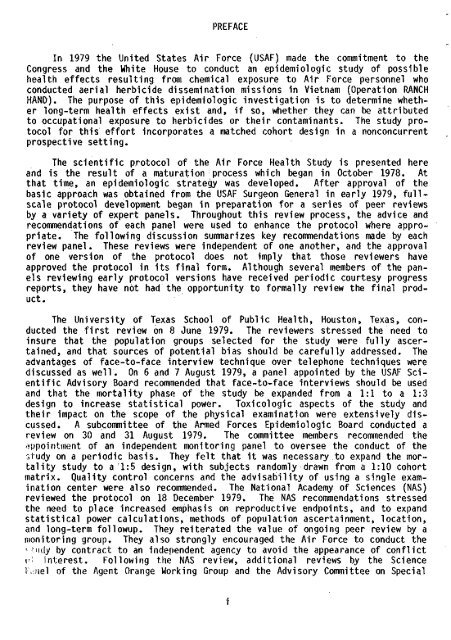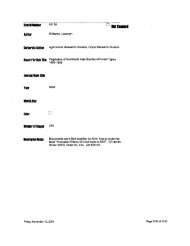Epidemiologic Investigation of Health Effects in Air Force Personnel ...
Epidemiologic Investigation of Health Effects in Air Force Personnel ...
Epidemiologic Investigation of Health Effects in Air Force Personnel ...
You also want an ePaper? Increase the reach of your titles
YUMPU automatically turns print PDFs into web optimized ePapers that Google loves.
PREFACE<br />
In 1979 the United States <strong>Air</strong> <strong>Force</strong> (USAF) made the commitment to the<br />
Congress and the White House to conduct an epidemiologic study <strong>of</strong> possible<br />
health effects result<strong>in</strong>g from chemical exposure to <strong>Air</strong> <strong>Force</strong> personnel who<br />
conducted aerial herbicide dissem<strong>in</strong>ation missions <strong>in</strong> Vietnam (Operation RANCH<br />
HAND). The purpose <strong>of</strong> this epidemiologic <strong>in</strong>vestigation is to determ<strong>in</strong>e whether<br />
long-term health effects exist and, if so, whether they can be attributed<br />
to occupational exposure to herbicides or their contam<strong>in</strong>ants. The study protocol<br />
for this effort <strong>in</strong>corporates a matched cohort design <strong>in</strong> a nonconcurrent<br />
prospective sett<strong>in</strong>g.<br />
The scientific protocol <strong>of</strong> the <strong>Air</strong> <strong>Force</strong> <strong>Health</strong> Study is presented here<br />
and is the result <strong>of</strong> a maturation process which began <strong>in</strong> October 1978. At<br />
that time, an epidemiologic strategy was developed. After approval <strong>of</strong> the<br />
basic approach was obta<strong>in</strong>ed from the USAF Surgeon General <strong>in</strong> early 1979, fullscale<br />
protocol development began <strong>in</strong> preparation for a series <strong>of</strong> peer reviews<br />
by a variety <strong>of</strong> expert panels. Throughout this review process, the advice and<br />
recommendations <strong>of</strong> each panel were used to enhance the protocol where appropriate.<br />
The follow<strong>in</strong>g discussion summarizes key recommendations made by each<br />
review panel. These reviews were <strong>in</strong>dependent <strong>of</strong> one another, and the approval<br />
<strong>of</strong> one version <strong>of</strong> the protocol does not imply that those reviewers have<br />
approved the protocol <strong>in</strong> its f<strong>in</strong>al form. Although several members <strong>of</strong> the panels<br />
review<strong>in</strong>g early protocol versions have received periodic courtesy progress<br />
reports, they have not had the opportunity to formally review the f<strong>in</strong>al product.<br />
The University <strong>of</strong> Texas School <strong>of</strong> Public <strong>Health</strong>, Houston, Texas, conducted<br />
the first review on 8 June 1979. The reviewers stressed the need to<br />
<strong>in</strong>sure that the population groups selected for the study were fully ascerta<strong>in</strong>ed,<br />
and that sources <strong>of</strong> potential bias should be carefully addressed. The<br />
advantages <strong>of</strong> face-to-face <strong>in</strong>terview technique over telephone techniques were<br />
discussed as well. On 6 and 7 August 1979, a panel appo<strong>in</strong>ted by the USAF Scientific<br />
Advisory Board recommended that face-to-face <strong>in</strong>terviews should be used<br />
and that the mortality phase <strong>of</strong> the study be expanded from a 1:1 to a 1:3<br />
design to <strong>in</strong>crease statistical power. Toxicologic aspects <strong>of</strong> the study and<br />
their impact on the scope <strong>of</strong> the physical exam<strong>in</strong>ation were extensively discussed.<br />
A subcommittee <strong>of</strong> the Armed <strong>Force</strong>s <strong>Epidemiologic</strong> Board conducted a<br />
review on 30 and 31 August 1979. The committee members recommended the<br />
appo<strong>in</strong>tment <strong>of</strong> an <strong>in</strong>dependent monitor<strong>in</strong>g panel to oversee the conduct <strong>of</strong> the<br />
study on a periodic basis. They felt that it was necessary to expand the mortality<br />
study to a 1:5 design, with subjects randomly drawn from a 1:10 cohort<br />
matrix. Quality control concerns and the advisability <strong>of</strong> us<strong>in</strong>g a s<strong>in</strong>gle exam<strong>in</strong>ation<br />
center were also recommended. The National Academy <strong>of</strong> Sciences (NAS)<br />
reviewed the protocol on 18 December 1979. The NAS recommendations stressed<br />
the need to place <strong>in</strong>creased emphasis on reproductive endpo<strong>in</strong>ts, and to expand<br />
statistical power calculations, methods <strong>of</strong> population ascerta<strong>in</strong>ment, location,<br />
and long-term followup. They reiterated the value <strong>of</strong> ongo<strong>in</strong>g peer review by a<br />
monitor<strong>in</strong>g group. They also strongly encouraged the <strong>Air</strong> <strong>Force</strong> to conduct the<br />
• • N.idy by contract to an <strong>in</strong>dependent agency to avoid the appearance <strong>of</strong> conflict<br />
(•> <strong>in</strong>terest. Follow<strong>in</strong>g the NAS review, additional reviews by the Science<br />
I ,:!iel <strong>of</strong> the Agent Orange Work<strong>in</strong>g Group and the Advisory Committee on Special
















